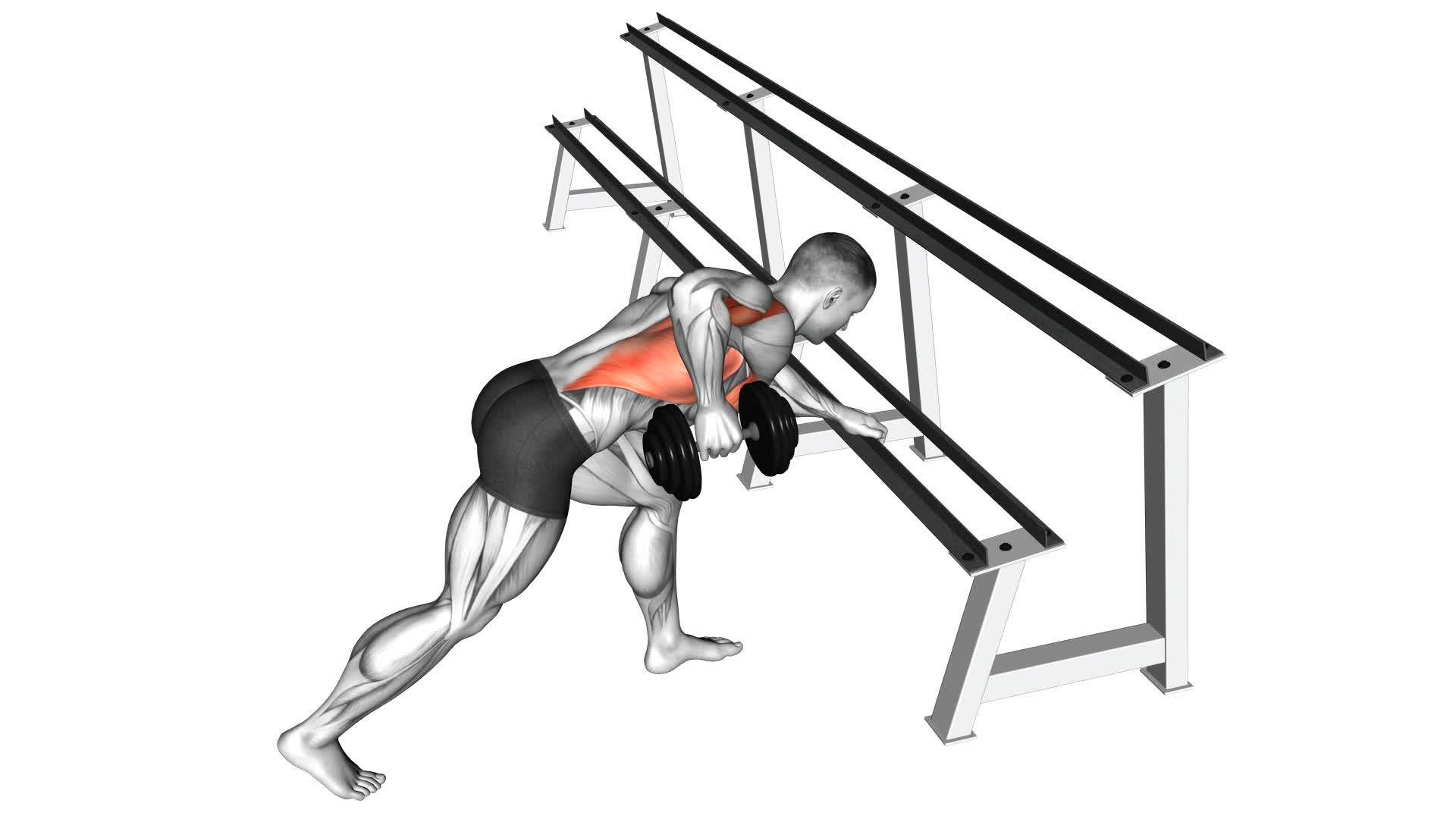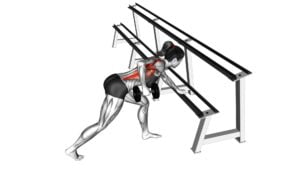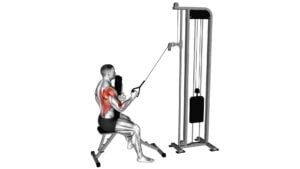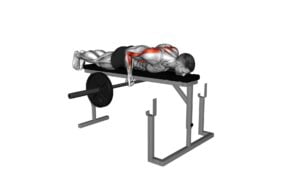Dumbbell One Arm Row (Rack Support) – Video Exercise Guide & Tips

Are you looking to strengthen your back and build muscle? Then you need to try the dumbbell one arm row exercise.
Watch This Exercise Video
In this video exercise guide and tips, we'll show you how to properly perform this exercise for maximum results. By using a second person point of view, we'll guide you through the proper form and technique, while also highlighting common mistakes to avoid.
Get ready to take your workout to the next level with the dumbbell one arm row!
Key Takeaways
- Dumbbell One Arm Rows strengthen and define the back muscles, particularly the latissimus dorsi (lats).
- They engage multiple back muscles like the rhomboids, trapezius, and rear deltoids, improving overall back strength and muscle development.
- Proper form and technique, including maintaining a straight back and avoiding rounding the shoulders, are crucial for preventing lower back strain and maximizing results.
- Variations and modifications, such as using kettlebells or resistance bands and targeting different muscle groups, can add intensity and variety to workouts.
Benefits of Dumbbell One Arm Row
You can achieve a stronger and more defined back by incorporating the dumbbell one arm row into your workout routine. This exercise specifically targets the muscles in your back, helping to increase overall back strength.
The dumbbell one arm row primarily targets the latissimus dorsi, or the lats, which are the large muscles on the sides of your back. These muscles play a crucial role in pulling movements and are responsible for a wide range of upper body movements.
In addition to targeting the lats, the dumbbell one arm row also engages other muscles in your back, such as the rhomboids, trapezius, and rear deltoids. These muscles work together to stabilize and support your spine, improving overall posture and reducing the risk of back injuries.
By incorporating the dumbbell one arm row into your workout routine, you can effectively strengthen and define your back muscles. This exercise allows you to isolate and focus on each side of your back individually, ensuring balanced strength and development.
To perform the dumbbell one arm row, start by placing one knee and hand on a bench, keeping your back straight. Hold a dumbbell in your free hand, and pull it towards your torso, squeezing your shoulder blades together. Lower the dumbbell back down with control and repeat for the desired number of repetitions.
Incorporating the dumbbell one arm row into your workout routine won't only increase your back strength but also help you achieve a more defined and sculpted back.
Proper Form and Technique
To ensure proper form and technique for the dumbbell one arm row, focus on maintaining a straight back and using controlled movements throughout the exercise. This will help you maximize the effectiveness of the exercise and reduce the risk of injury. Here are some key points to keep in mind:
- Importance of warm up exercises: Before starting the dumbbell one arm row, it's crucial to warm up your muscles and prepare your body for the workout. This can be done through dynamic stretches or light cardio exercises to increase blood flow and flexibility.
- How to prevent lower back strain: Lower back strain is a common issue when performing the dumbbell one arm row. To prevent this, engage your core muscles throughout the exercise to support your lower back. Avoid rounding or arching your back and focus on maintaining a neutral spine position.
- Controlled movements: During the exercise, make sure to use controlled movements and avoid jerking or swinging the weight. This will help target the intended muscles and reduce the risk of injury.
- Straight back: Keep your back straight throughout the exercise to maintain proper form. Avoid hunching or rounding your shoulders, as this can put unnecessary strain on your neck and upper back.
Common Mistakes to Avoid
When performing the dumbbell one arm row, it's important to be aware of common mistakes that should be avoided to ensure proper form and maximize the effectiveness of the exercise.
One common error in dumbbell row technique is using too heavy of a weight. This can lead to improper form and strain on the muscles, increasing the risk of injury. To fix this, start with a lighter weight and focus on mastering the proper technique before gradually increasing the weight.
Another common mistake is rounding the back during the movement. This not only reduces the effectiveness of the exercise but also puts unnecessary strain on the spine. To fix this, make sure to keep your back straight and engage your core muscles throughout the entire movement.
Improper grip is also a common error. Gripping the dumbbell too tightly can cause tension in the forearm muscles and limit the range of motion. To fix this, maintain a relaxed grip on the dumbbell and focus on squeezing the back muscles as you lift the weight.
Lastly, rushing through the exercise is another mistake to avoid. Performing the one arm row too quickly can compromise form and prevent you from fully engaging the targeted muscles. Instead, focus on a slow and controlled movement, emphasizing the contraction of the back muscles at the top of the movement.
Tips for Maximizing Results
To maximize results with the dumbbell one arm row, focus on maintaining proper form and gradually increasing the weight for progressive overload. Here are some tips to help you maximize your results:
- Importance of rest and recovery: Make sure to give your body enough time to rest and recover between workouts. This allows your muscles to repair and grow stronger.
- How to track progress and set goals: Keep a workout journal or use a fitness tracking app to record your sets, reps, and weights. This will help you track your progress over time and set achievable goals.
- Gradually increase weight: As you get stronger, gradually increase the weight you use for the dumbbell one arm row. This will ensure that you continue to challenge your muscles and stimulate growth.
- Focus on proper form: Maintaining proper form is crucial for maximizing results and preventing injuries. Keep your back straight, engage your core, and pull the dumbbell towards your hip in a controlled manner.
Variations and Modifications
For a different challenge, try incorporating variations and modifications into your dumbbell one arm row workouts. Adding variety to your routine can help prevent boredom and keep your muscles guessing, leading to better results. There are several alternative rowing exercises you can try to target different muscle groups and add intensity to your workouts.
One option is the bent-over barbell row, which requires a barbell instead of dumbbells. This exercise engages multiple muscles in your back, shoulders, and arms. Another alternative is the seated cable row, where you use a cable machine instead of free weights. This exercise allows for a smooth and controlled movement, targeting your back muscles.
When it comes to equipment options for one arm rows, you can use a variety of tools. In addition to dumbbells, you can use kettlebells or resistance bands. Kettlebells provide a unique grip and shape, challenging your muscles in a different way. Resistance bands are portable and versatile, allowing you to perform one arm rows anywhere. Additionally, you can use machines specifically designed for one arm rows, such as the T-bar row machine or the seated row machine. These machines provide stability and support, making it easier to focus on your form and target your back muscles effectively.
Incorporating variations and modifications into your dumbbell one arm row workouts can help you break plateaus, build strength, and improve overall muscle development. Remember to start with lighter weights and gradually increase the intensity as your muscles adapt. Always prioritize proper form and technique to avoid injury and maximize the benefits of each exercise.
Frequently Asked Questions
How Many Sets and Reps Should I Do for the Dumbbell One Arm Row Exercise?
For optimal results with the dumbbell one arm row exercise, it's important to focus on the right weight and progression. Start with a weight that challenges you but allows you to maintain proper form. Aim for 3-4 sets of 8-12 reps per arm, gradually increasing the weight as you get stronger.
Avoid common mistakes like using momentum or rounding your back. Remember to engage your core and keep your shoulder blades pulled back throughout the exercise.
Can I Perform the Dumbbell One Arm Row Exercise if I Have a Shoulder Injury?
If you have a shoulder injury, it's important to consult with a healthcare professional before attempting the dumbbell one arm row exercise. They can provide guidance on whether it's safe for you to perform this exercise or suggest modifications that will be more suitable for your condition.
There are also alternative exercises that can target similar muscle groups without putting strain on your injured shoulder.
Always prioritize your safety and listen to your body when working out.
Is It Necessary to Use a Rack for Support While Performing the Dumbbell One Arm Row Exercise?
Using a rack for support during the dumbbell one arm row exercise has its benefits. It helps maintain stability and proper form, reducing the risk of injury.
However, if you don't have access to a rack, there are variations you can try. You can perform the exercise by placing your non-working hand on a bench or a stable surface, or by using a resistance band instead of a dumbbell.
Just remember to focus on maintaining good posture and engaging your back muscles throughout the movement.
How Often Should I Incorporate the Dumbbell One Arm Row Exercise Into My Workout Routine?
To incorporate the dumbbell one arm row into your workout routine, consider performing it 2-3 times a week. This exercise targets your back muscles and can help improve strength and posture.
By adding variety to your routine, you can challenge your muscles and prevent plateaus. Remember to start with a weight that allows you to maintain proper form and gradually increase the resistance as you get stronger.
Consult with a professional trainer for personalized guidance.
Can I Use a Kettlebell Instead of a Dumbbell for the Dumbbell One Arm Row Exercise?
Yes, you can use a kettlebell as a substitution for the dumbbell in the one arm row exercise.
The benefits of the dumbbell one arm row include strengthening your back, shoulders, and arms.
Using a kettlebell instead of a dumbbell can add an extra challenge to your workout and engage your muscles in a slightly different way.
Remember to maintain proper form and technique to avoid injury and maximize the benefits of the exercise.
Conclusion
In conclusion, the dumbbell one arm row is a highly effective exercise for targeting the back muscles.
By maintaining proper form and avoiding common mistakes, you can maximize the benefits of this exercise.
Remember to use variations and modifications to challenge yourself and keep your workouts interesting.
With consistent practice and attention to form, you can achieve great results with the dumbbell one arm row.

Author
Years ago, the spark of my life’s passion ignited in my mind the moment I stepped into the local gym for the first time. The inaugural bead of perspiration, the initial endeavor, the very first surge of endorphins, and a sense of pride that washed over me post-workout marked the beginning of my deep-seated interest in strength sports, fitness, and sports nutrition. This very curiosity blossomed rapidly into a profound fascination, propelling me to earn a Master’s degree in Physical Education from the Academy of Physical Education in Krakow, followed by a Sports Manager diploma from the Jagiellonian University. My journey of growth led me to gain more specialized qualifications, such as being a certified personal trainer with a focus on sports dietetics, a lifeguard, and an instructor for wellness and corrective gymnastics. Theoretical knowledge paired seamlessly with practical experience, reinforcing my belief that the transformation of individuals under my guidance was also a reflection of my personal growth. This belief holds true even today. Each day, I strive to push the boundaries and explore new realms. These realms gently elevate me to greater heights. The unique combination of passion for my field and the continuous quest for growth fuels my drive to break new ground.







